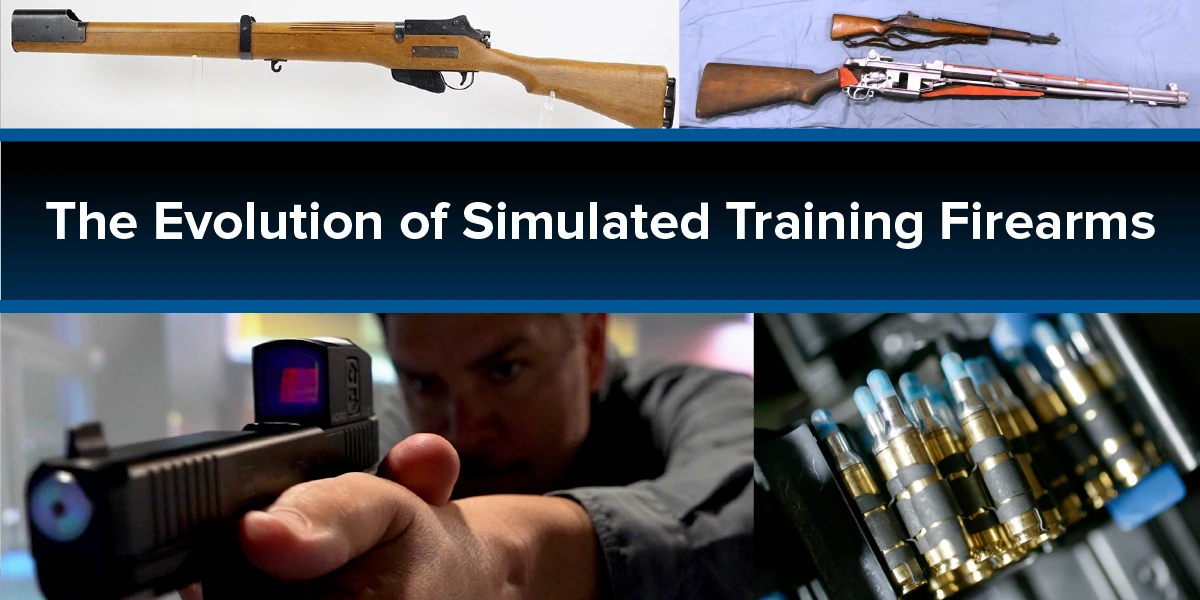
Recoil and Roll Call
From the drill rifles that predated the First World War to high-tech laser systems that police use today, firearms simulation training dates back further than one might expect. The evolution of firearms simulators shows a journey from simple inert devices to sophisticated, digital systems used by modern military and law enforcement agencies. Let’s look at the firearms simulators of yesteryear to grasp how far the technology has come.
Training guns have been around nearly as long as their functional counterparts because firearms training carries inherent risk. During the late 19th century, drill instructors realized the benefits of equipping recruits with non-firing dummy rifles, or “drill rifles,” to reduce injuries during practice bayonet charges.
However, these training tools were entirely inert. Technology needed to evolve for a more realistic solution to fall into trainees hands.
The Swift Training Rifle
Two world wars showed that armed forces could increase training volume by reducing ammunition costs. Enter the Swift Training Rifle. This and similar designs employed spring-loaded needles that, when combined with proprietary paper targets, taught trainees proper shooting and aiming techniques. These tools were cheap to manufacture and moderately effective for instructors, giving recruits hands-on experience before their time on a live range.
The Rise of Digital Simulators in Police Training
The increased outcry for police training in the 1970s and 80s gave firearm simulation tech the shot in the arm it needed to go beyond its analog roots. 1983 marked the first adoption of a full-fledged “shoot-don’t-shoot” simulator – with The Simulated Media Environment Program. This behemoth featured an early computer, 8-channel tape, a video camera, 24 slide projectors, and a revolver loaded with blanks. This $600,000 system used sound detection to document an officer’s decisions, but the crude technology had several drawbacks- chiefly that the characters in the “scenarios” wouldn’t always respond to being shot.
Firearms Simulation Training Technology Enters the Information Age
Rapid innovation in computer graphics during the 80s and 90s paved the way for systems that more closely resemble those used today. FATs, or Firearms Training Systems, was an early innovator. Pioneered by Formula One racer Jody Scheckter, FATS was designed to improve upon existing laser shooting simulators, many of which more closely resembled “duck-hunt”-style video games. This system used a single screen and a tethered laser targeting system to train recruits. Systems like VirTra improved on this initial design by adding untethered, modified service weapons and multiscreen immersion.
VirTra has continued to build on the rich legacy of this lifesaving technology. Current VirTra systems feature high-resolution projected environments designed to simulate complex real-world scenarios that branch depending on user decisions. These systems allow trainees to practice in simulated situations that test their marksmanship and judgment in high-stress environments. Using untethered, modified service weapons enhances realism, while multiscreen setups provide a fully immersive, 300-degree experience that mimics the level of awareness needed in real-life situations.
Additions like True-Fire have further advanced the field by offering a true-to-life recoil simulation without false fire, or shots actuated without a trigger pull. Tools like Advanced Skills Magazines also play a key role, as instructors can remotely simulate different weapon malfunctions, forcing trainees to practice clearing jams on the fly. Together, these innovations ensure that today’s simulation technology prepares law enforcement and military personnel more effectively than ever. They offer the closest experience possible to real-life situations and combat without the associated risks while eschewing the cost of training scenario actors.
Firearms simulation technology has come a long way from its early days of drill rifles and analog systems, developing into highly sophisticated tools that offer realistic, immersive training experiences. As social and combat landscapes evolve, VirTra will continue to serve at the forefront of simulator technology to provide solutions that prepare the men and women in uniform that will face them.
To speak with a VirTra specialist about how your agency can join this forefront of firearms simulation technology, click here.
Sources:
Benefits of simulated recoil: https://www.sciencedirect.com/science/article/pii/S2214914719301163
Swift training rifle: https://www.rifleman.org.uk/The_Swift_training_rifle.html
Beginning of police simulator training: https://tedium.co/2018/10/23/police-training-simulator-history/
Early Attempts at Simulated Firearm Kits: https://worap.wordpress.com/2016/11/03/classic-replica-air-pistol-review-crosman-38-revolvers/
Recently Published
Join Our Newsletter









